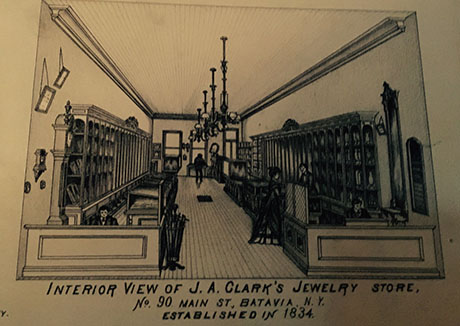
In 1834, an early jeweler, Jerome A. Clark, owned a jewelry store at 90 Main Street, Batavia, NY. George Austin worked at Clark's jewelry store after school. A few years later, Charles Prescott came to work as a clerk for Mr. Clark, and a friendship was formed between the two younger men. In 1885, the young men purchased the Clark estate business, which became Austin and Prescott. Mr. Austin died in 1914, and as part of his estate, $30,000 went to the village to develop a public park. Now you know how Austin Park got its name. He left his interest in the business to William Hopp, who took over the company and moved to the Masonic Temple. Louis Weiner became the next owner, and in 1957 he moved across the street to the C.L. Carr Store where Robert Carr gave him a tiny corner next to the elevator for a workshop.
Between 1887 and 1928, on the corner of Main and Jackson Street, C.C. Bradley opened a jewelry store. In 1909, Bradley bought the entire corner lot and built the three-story Curtis Building. His modern jewelry store was located on the first floor.
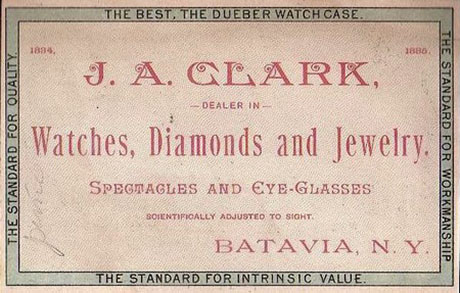
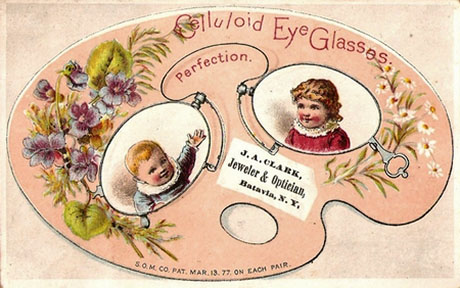
Mr. E. R. Muller had been a watchmaker for Bradley and continued his association with Mr. Bradley until 1898 when he went into business for himself. Muller's first store was at 2 Jackson Street "called "The Little Shop Around the Corner." In 1905, he moved to 57 Main St. Mr. Muller went to school in Germany and learned watch-making and repair there. He was the father of Miss Zita and Hildred Muller. (Zita Muller was the principal at John Kennedy School for many years in the early 1950s.) In 1917, Mr. Bradley sold the Curtis Building to the F.W. Woolworth Company and moved his jewelry store across Main Street to 96 Main. \Two years later, in 1929, he sold the jewelry store to Mr. and Mrs. Robert Mead, as well as, Mrs. Mead's sister, Miss Ann Francis.
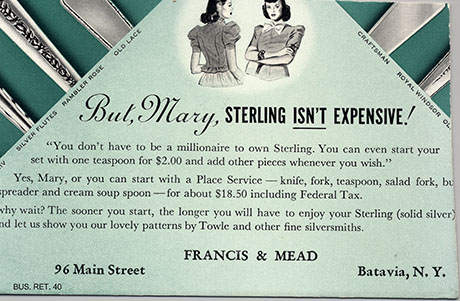
In 1925, Mr. Sam Blumberg bought Muller's business and ran it under Blumberg's or as the Gift Center on 57 Main St. until 1949, when it moved next door to 55 Main Street and leased 57 Main Street's Thing's Shoe Store. Theodore Freeman later managed the Gift Center for the Blumbergs. The Urban Renewal Agency razed 55 and 57 Main St. in 1966.
Looking at Batavia Directories from 1900 to 2015, I noted many interesting facts about our early jewelry stores.
In 1900, there were three jewelry stores in Batavia. In 1919, two more jewelry stores were added to the list. The street number of 90 Main St., was home to many jewelry stores. Urban renewal took the entire north side of Main Street. Francis and Mead at 96 Main St., Ingraham Jewelers at 2 Main St., and Herb Brenner at 124 Main St. ("It's ok to owe Herb Brenner") were the few jewelry stores that stayed in the exact location. Other jewelers from the area were William Hopp, J.W. Dabney, Warren Cole, Josiah Dabney, Samuel Blumberg, Gordon Way, Morways and Hall Jewelers, to name a few. Krtanik Jewelers was another long-lasting jewelry store in the area.
Today, there are two jewelry stores in Batavia. Valle Jewelers, a family-owned business since 1951, located on 21 Jackson St., and Lambert's Design Jewelers operated by family members at 375 West Main St.
So what was the connection I mentioned in the first sentence of this article? In 1969, a young gas station attendant pumped gas at Moretto's Service Station, an elderly gentleman approached him and said he needed some money. He asked if he could get $10 for either a wristwatch or a pocket watch. $10 was a full day's pay. The attendant chose the pocket watch. The gentleman gave up the watch with sadness and asked the young man if he could take care of the watch by keeping it clean and wound. He also asked if he returned with the $10 could he get his pocket watch back. The attendant said yes! That was 52 years ago. This young man always wondered where the watch came from and felt terrible that the gentleman never came back for the watch. An engraving on the watch said the watch was made especially for J. A. Clark, Batavia, NY, by Paul Breton Geneva, Switzerland. In looking at an 1876 atlas was a picture of J. A. Clark's Jewelry Store. In addition, there was a map of early Batavia. J. A Clark's home was built at the foot of Jackson Street. Rumor has it that he could step out on the balcony of his third floor home and, with the help of binoculars, could check on the women working in his store.
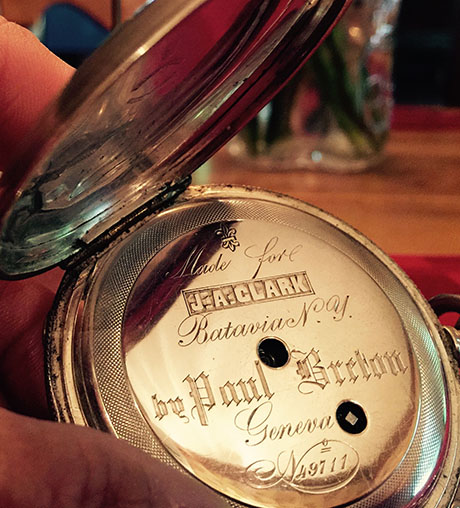
So where is the watch now? It is encased in a glass-domed pocket watch holder, sitting on an oak sideboard. You see, J. A. Clark's home was built at 1 Chestnut St.; that just happens to be the home of the unique pocket watch with the amazing story of coming home! The gas station attendant just happens to be my husband, Richard. We are thrilled to be the owners of this special pocket watch.

